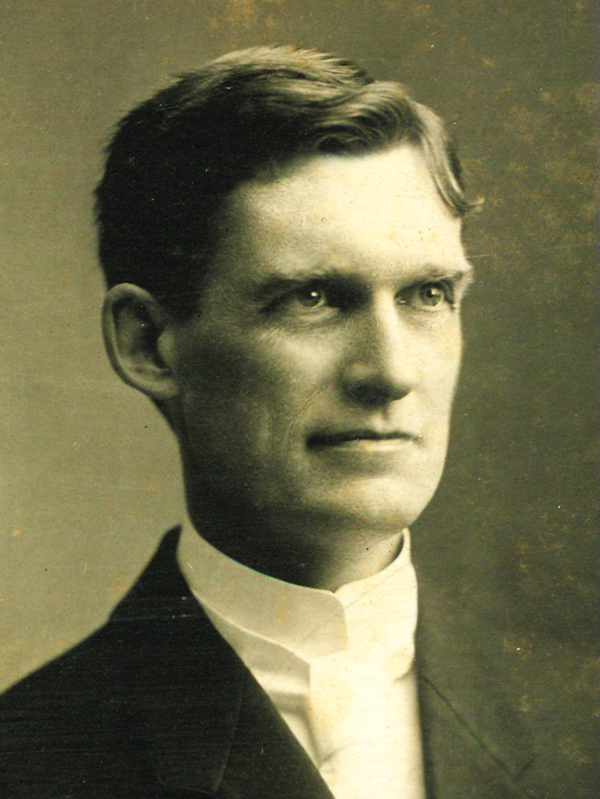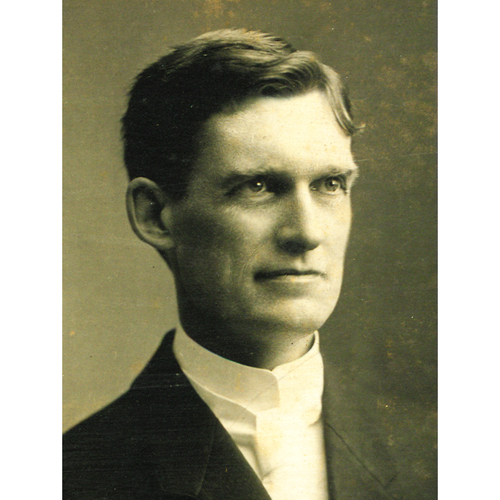
Source: Link
ROBERTSON, SAMUEL NAPIER, educator; b. 6 July 1869 in Cape Traverse, P.E.I., son of John Robertson and Isabella Carruthers; m. 1922 Annie Laura McGrath of Tignish, P.E.I.; they had no children; d. 3 Oct. 1937 in Charlottetown.
When Samuel Robertson was a boy, his father, a sea captain, was lost off the Newfoundland coast. His mother moved with her four children to North Bedeque, P.E.I., where her brother Robert lived. Samuel received his elementary education in a rural school and in 1884 enrolled in Charlottetown’s Prince of Wales College, a secular, co-educational institution offering high school and what seems to have been the equivalent of first-year university programs. He studied under Alexander Anderson*, a gifted and demanding teacher who ran the college from 1868 to 1901. Robertson graduated in 1887, winning a medal for the best student of the year, and went on to Dalhousie College in Halifax on a $150 bursary. He majored in the classics and obtained a ba. In 1893, after working for a year at a high school in Alberton, P.E.I., he entered Prince of Wales College as a faculty member; there he would teach English, Latin, and Greek. Alexander Anderson had a high opinion of Robertson: “In the performance of his duties he was uniformly able, earnest and conscientious, and as a colleague he was genial, helpful and gentlemanly.” To improve his qualifications, Robertson left in 1895 to enroll at Union Theological Seminary in New York, and subsequently he studied briefly at Johns Hopkins University in Baltimore, Md. He returned a year later to Prince of Wales and took over the principal’s job when Anderson became the Island’s chief superintendent of education in 1901. Dalhousie gave Robertson his master’s degree that year, and later an honorary lld.
Described by former students as “austere,” “strait-laced,” and “puritanical,” Robertson was a bookish bachelor, devoted to his church and his college. A strict disciplinarian, he saw to it that his students avoided the vices of sloth, tardiness, and frivolous or indecorous behaviour. Most mornings found him patrolling the corridors, watch in hand, to ambush latecomers. He permitted sports, but only insofar as they contributed to physical and mental health. He insisted that male and female students use separate entrances and stairways. He refused to allow Saturday-night dances at the college. (Invited to attend a dance at the Young Men’s Christian Association, he appeared briefly and declared, “I just wanted to see how many of you were up here wasting your parents’ money, when you should be home studying.”) To his credit, Robertson practised the virtues that he preached. In addition to fulfilling his administrative duties, he taught during most periods of the college day, his subjects being Greek, Latin, ancient history, and teacher training. On Sundays he led a Bible class at the Church of Scotland, of which he was an elder. “Personally he was one of the most charitable men in the community,” his colleague John Tougas Croteau would write. “He paid many a poor boy’s way through college, and gave quantities of food and coal to poor families in the town.” Charlottetown boarding houses, usually crowded and uncomfortable, served as residences for most students. Robertson worried about their living conditions and physical health as well as their academic progress. “He was a man of vast sympathy for all in need of advice or counselling,” former student Joseph Devereux recalled. “His patience was remarkable and his office door was literally always open.” His students referred to him as “the Doc”; some of his colleagues called him “Saint Samuel” (it is unclear whether this description related to his piety or his acts of charity).
Aside from the work he did for his church and the cause of temperance, Robertson had little contact with the community, but he clearly felt constrained to try to influence the Island’s public-school system. As late as 1929, when 414 of the province’s 470 schools had one room, about half the children who began the first grade were dropping out before the eighth grade. The attendance rate in rural schools was less than 70 per cent. Many teachers were young and inexperienced. Poverty often meant that children had to work on the family farm or bring in wages. Robertson fretted continually about Islanders’ attitude towards learning. “The people of the province fail to realize that there has been a great change in world conditions in recent years,” he wrote in 1921. “They do not realize that their children are going out to earn a livelihood in an educated world, in which their educational handicap will exact a tremendous toll.”
For Robertson, a great deficiency in the Island’s schools – including his own – was the lack of library books. When the college building was destroyed by fire in February 1932, he was greatly distressed by the loss of his personal collection; according to bystanders, he had to be restrained from entering the burning building. He arranged with the Board of Education for classes to be held in city schools while a new brick and stone structure was being created. The Carnegie Corporation of New York, which had become interested in Maritime education during the 1920s college-federation debates [see Arthur Stanley Mackenzie; George Frederick Pearson], donated $4,500 to establish a college library and $110,000 to the province for a circulating-library system, which was housed in the basement of Prince of Wales.
Although he favoured lifelong learning, Robertson declined to take part in the extension work embraced in the 1930s by St Dunstan’s, the Roman Catholic university, in connection with the cooperative movement then sweeping the Island. The movement included the formation of self-help adult-education groups. Robertson’s approach focused on individual commitment rather than community endeavours. He believed that the circulating library was “the great implement to accomplish the education of the people of this province.” Once out of school, Islanders could continue their education for their entire lives. “Then only,” he wrote in 1936, “shall one know the meaning of ‘Adult Education’ and its method.”
Most of Robertson’s students came from farms, and he was under considerable pressure to add more practical courses to a classics-based curriculum designed mainly to train teachers and scholars. The college set up programs in manual training and household science and expanded agricultural studies in the early 1900s. A two-year commercial course was established in 1924. After the 1932 fire, the Carnegie Corporation enabled Prince of Wales to add a fourth year to its curriculum – the equivalent of a second-year university program – and three new subjects: biology, economics, and sociology. It became a junior college offering limited vocational training. But Robertson railed against the view that “there shall be only science, and lots of it,” or that an education had value only when it led directly to employment. Throughout his 36-year reign, despite complaints from the public about the high failure rate at Prince of Wales, he maintained the exacting academic standards set by his predecessors. According to J. T. Croteau, who was extremely active in the cooperative movement opposed by Robertson, the principal was “merciless” in marking exams, and it was not unusual for a third of his students to fail at the end of a semester.
In 1922, at the age of 53, the shy bachelor had married Annie Laura McGrath, a 41-year-old Catholic professor of English and botany at Prince of Wales. At a time when the Island was still sharply divided on religious lines, the marriage was highly unusual. He went to his church and she went to hers, but before her death in 1953, Annie Laura would arrange to be buried next to her husband in the Protestant cemetery in Sherwood, then on the outskirts of Charlottetown.
Robertson died in office in 1937, at 68, apparently of a heart attack. Appropriately, his funeral service, one of the largest ever held on the Island, took place in the college. The procession, led by about 500 students on foot, extended for several city blocks.
During Robertson’s years as principal of Prince of Wales, enrolment grew from 176 to 449, and the faculty from 5 to more than 20. Despite the difficulties of expansion and the setbacks caused by fire, hard economic times, and attitudes that he found unsympathetic, Robertson kept his school on the course laid down in the 1800s. He upheld rigorous academic standards, campaigned for school improvements, and encouraged higher learning among generations of bright young Islanders. Although Prince of Wales College ceased to exist in 1969 and was replaced by the University of Prince Edward Island, Robertson’s contribution to the cause of lifelong learning was recognized when the new institution named its library after him.
PARO, Acc. 3095, Reg. of baptisms, Cape Traverse, 1869 (transcript available online at www.gov.pe.ca/archives/baptismal). Private arch., Marian Bruce (Murray River, P.E.I.), Notes from interviews with Eleanor Lowe (Charlottetown), 7 April 2004 and John R. McGrath (Norway, P.E.I.), 16 April 2004; Carolyn Roberts MacQuaid (Charlottetown), Notes from an interview with Catherine Coyle (Charlottetown), 22 Aug. 2002. Sherwood Cemetery (Charlottetown), Burial records. Univ. of P.E.I., Robertson Library, Univ. Arch. & Special Coll., P.E.I. Coll. (Charlottetown), Joseph Devereux, “Looking backward” (typescript, n.d.); H. F. MacEwen, “Samuel N. Robertson, educator” (typescript, 1978). Charlottetown Guardian, 11 May 1918; 11–31 May 1919; 29 May, 3–13 Oct. 1920; 17 Jan. 1933; 4 Oct. 1937. Patriot, 2–13 Oct. 1920; 26 May 1923; 14 Jan., 17 Feb. 1933; 4–6 Oct. 1937. Prince of Wales College Observer (Charlottetown), March 1901. Marian Bruce, A century of excellence: Prince of Wales College, 1860–1969 (Charlottetown, 2005). College Times (Charlottetown), December 1931–December 1937. J. T. Croteau, Cradled in the waves (Toronto, 1951). G. E. MacDonald, The history of St. Dunstan’s University, 1855–1956 (Charlottetown, 1989). Helen MacDonald, “An affectionate look back at Dr. Sammie and PWC,” in Moments in time and other memories: a compilation of stories (2v., Charlottetown, 1989–90), 2: 10–20. P.E.I., House of Assembly, Journal, 1888; Legislative Assembly, Journal, 1894, 1902, 1918, 1934–36, 1938; reports of the principal of Prince of Wales College, 1896, app.E and 1921; report of the royal commission on education in the province of Prince Edward Island, 1930. Lester Sellick, Some Island men I remember (Hantsport, N.S., 1980). P. B. Waite, The lives of Dalhousie University (2v., Montreal and Kingston, Ont., 1994–98), 1.
Cite This Article
Marian C. Bruce, “ROBERTSON, SAMUEL NAPIER,” in Dictionary of Canadian Biography, vol. 16, University of Toronto/Université Laval, 2003–, accessed December 20, 2024, https://www.biographi.ca/en/bio/robertson_samuel_napier_16E.html.
The citation above shows the format for footnotes and endnotes according to the Chicago manual of style (16th edition). Information to be used in other citation formats:
| Permalink: | https://www.biographi.ca/en/bio/robertson_samuel_napier_16E.html |
| Author of Article: | Marian C. Bruce |
| Title of Article: | ROBERTSON, SAMUEL NAPIER |
| Publication Name: | Dictionary of Canadian Biography, vol. 16 |
| Publisher: | University of Toronto/Université Laval |
| Year of publication: | 2013 |
| Year of revision: | 2013 |
| Access Date: | December 20, 2024 |



